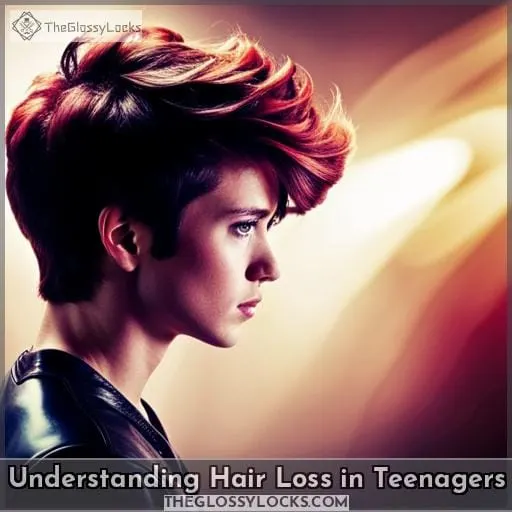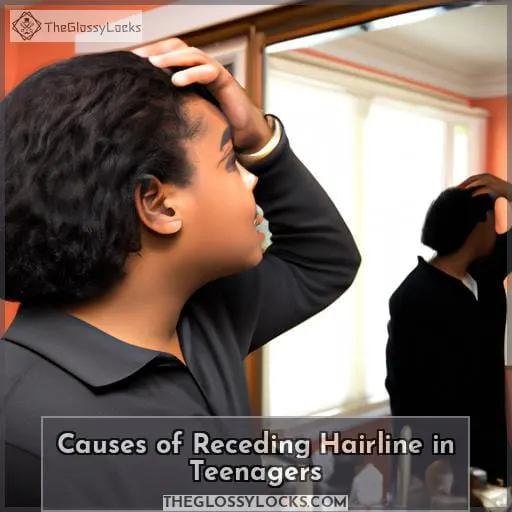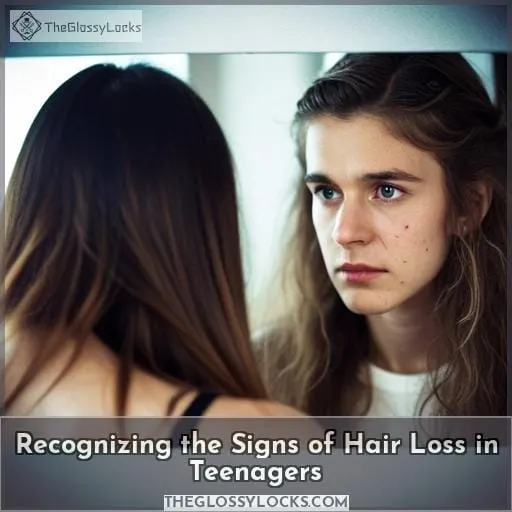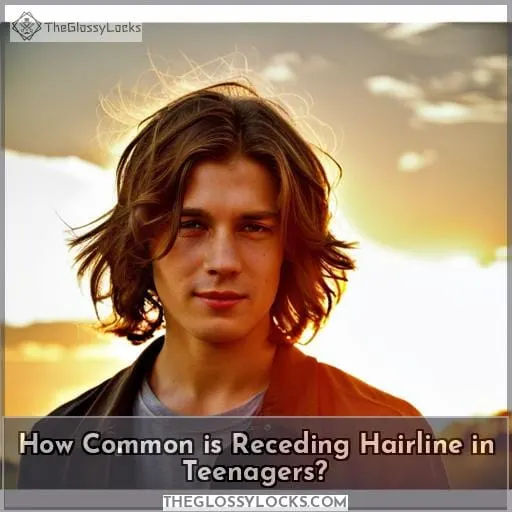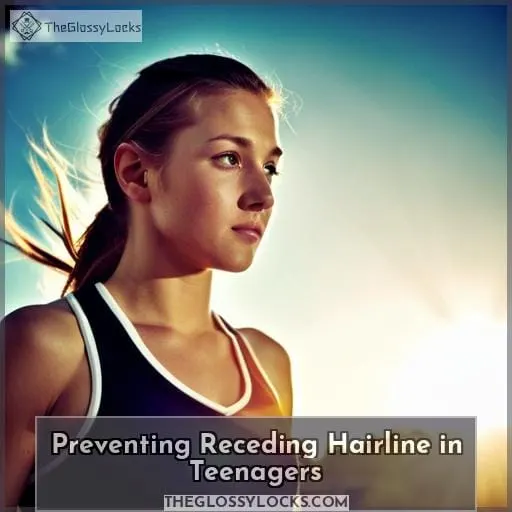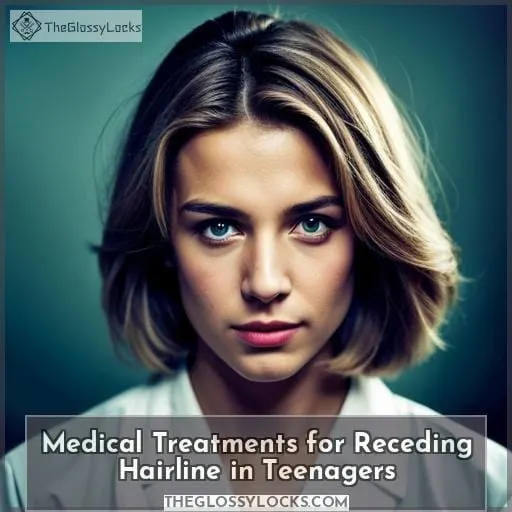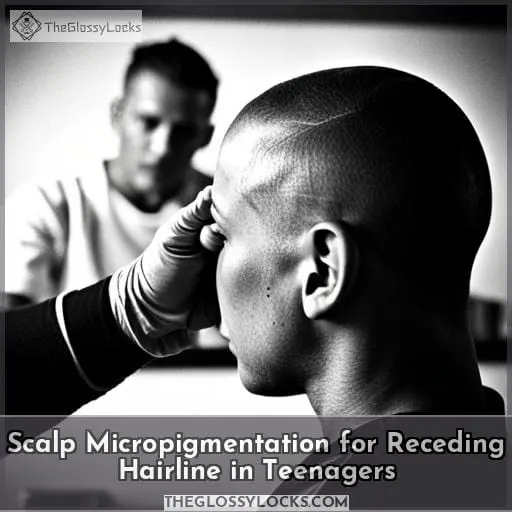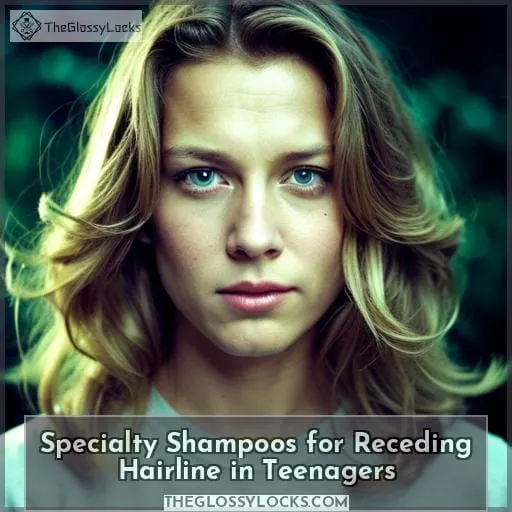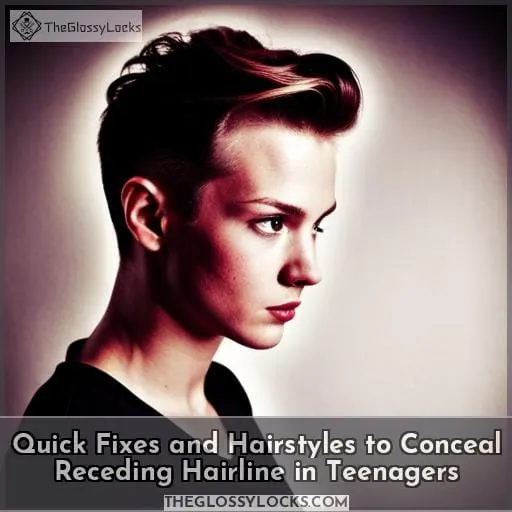This site is supported by our readers. We may earn a commission, at no cost to you, if you purchase through links.
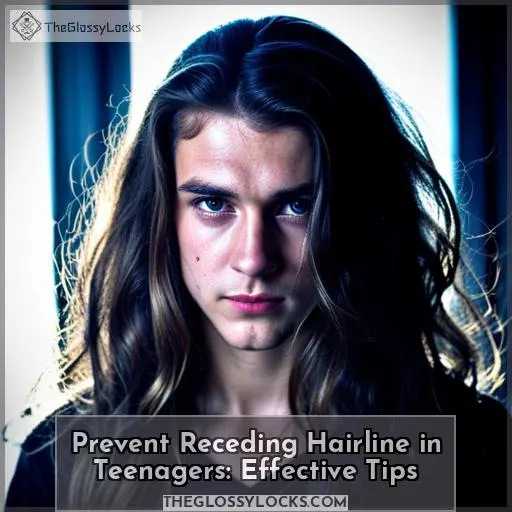
Table Of Contents
- Key Takeaways
- Understanding Hair Loss in Teenagers
- Causes of Receding Hairline in Teenagers
- Recognizing the Signs of Hair Loss in Teenagers
- How Common is Receding Hairline in Teenagers?
- Preventing Receding Hairline in Teenagers
- Medical Treatments for Receding Hairline in Teenagers
- Therapy Options for Receding Hairline in Teenagers
- Scalp Micropigmentation for Receding Hairline in Teenagers
- Specialty Shampoos for Receding Hairline in Teenagers
- Quick Fixes and Hairstyles to Conceal Receding Hairline in Teenagers
- Conclusion
Key Takeaways
- Genetics, hormones, diet, and stress contribute to teenage hair loss.
- A balanced diet with antioxidants and herbal remedies can help prevent hair loss.
- Avoid tight hairstyles, excessive heat styling, and choose natural hair care products.
- Medical treatments like finasteride, minoxidil, and scalp micropigmentation can be explored for prevention.
Understanding Hair Loss in Teenagers
If you’re a teen, it’s important to be aware of the potential causes of hair loss and take steps now to help maintain healthy hair growth. Teenage hair loss is often due to hormonal changes or genetics, but it can also result from nutritional deficiencies, medical conditions, medications, and stress.
Prevention measures include eating a balanced diet rich in antioxidants. You can also use herbal remedies such as Chinese hibiscus, ginseng, and saw palmetto for their nutrients. Managing stress through exercise or relaxation techniques like meditation is also important.
Additionally, it’s crucial to avoid over-styling or tight hairstyles that can damage your scalp.
All of these measures are essential if you want to prevent a receding hairline in your teenage years. Along with preventive measures, there are treatments available too. Finasteride (oral/topical) and minoxidil may help combat issues related to male pattern baldness.
Low-level laser therapy works on reducing inflammation, which could further lead to thinning of hair at early stages itself.
If you recognize any signs of unhealthy hair, it’s important to consult a doctor.
Causes of Receding Hairline in Teenagers
You may experience a receding hairline in your teenage years due to various factors. Hormonal changes, medical conditions, and lifestyle choices can all contribute to this type of hair loss. Genetics also plays an important role as male pattern baldness is hereditary and often starts during adolescence.
Additionally, diet and stress levels can influence the health of your hair follicles over time. To prevent or reduce the risk of a receding hairline, it’s essential to maintain a healthy lifestyle. This includes eating nutritious foods with antioxidants that promote scalp health, like green tea or soy products.
Avoiding tight hairstyles such as cornrows and not over-styling with heat tools too frequently can help protect your hair. For men experiencing male pattern baldness before it progresses further into their teens, using treatments like finasteride can be beneficial.
It’s important to take supplements when necessary, according to a doctor’s instructions, if nutrient deficiencies occur from dietary restrictions.
These are just some steps you should take towards preventing or reducing potential damage associated with teenage receding hairlines.
Recognizing the Signs of Hair Loss in Teenagers
Recognizing the signs of hair loss in teenagers can be daunting, but it’s important to note that 16 percent of males aged 15-17 experience some degree of male pattern baldness.
Early signs include changes in the hairline and thinning, as well as shedding and receding.
To prevent further damage or even reverse effects, there are a few steps young men can take:
- Nutritional support: Eating foods rich in antioxidants like fruits and vegetables may help maintain healthy follicles.
- Herbal remedies: Chinese hibiscus, ginseng root extract, and saw palmetto berries have been shown to improve scalp health.
- Hairstyling tips: Avoid over-styling your hair with tight styles or using too much heat for styling purposes.
It is also important to manage stress levels through relaxation techniques such as yoga or meditation, which will help lower DHT levels associated with hair loss due to hormone imbalance.
Consulting a doctor about medical conditions related to teenage years should be taken into consideration when experiencing severe symptoms, such as sudden patches on the scalp showing no regrowth after several weeks.
Taking these preventive measures at an early stage will ensure that teenagers stay ahead of any form of permanent structural damage!
How Common is Receding Hairline in Teenagers?
Receding hairline in teenagers is common, but it can be prevented. It’s important to understand the genetic and hormonal factors that lead to teenage hair loss so you can take preventive measures.
- Eat a healthy diet rich in antioxidants.
- Lower DHT levels with foods like green tea and soybeans or through medications such as finasteride and minoxidil.
- Consider herbal remedies like Chinese hibiscus, ginseng, and saw palmetto for supporting overall hair health.
Preventing Receding Hairline in Teenagers
Preventing a receding hairline in teenage years is possible through a healthy diet and nutrient supplements, herbal remedies, and essential oils, as well as proper hair care practices and products. Moreover, managing stress levels along with leading an overall healthy lifestyle is also a key factor in preventing receding hairlines.
Healthy Diet and Nutrient Supplements
Eating a balanced diet full of antioxidant-rich foods and taking nutrient supplements can help you keep your hair looking healthy! Make sure to include proteins, vitamins A and C, zinc, and iron for proper nutritional support.
Consider biotin or other hair loss prevention shampoos, plus essential oils in your dietary choices.
Herbal Remedies and Essential Oils
Discover how herbal remedies and essential oils can help you maintain a healthy scalp. Aromatherapy benefits, such as stress reduction, may also support hair loss prevention. Essential oil safety is important – use properly diluted oils for the best results! Scalp massage techniques are easy to learn and might boost circulation in your scalp.
The effectiveness of herbal remedies varies; research which ones work best for you before using them.
Hair Care Practices and Products
To maintain a healthy head of hair, try using natural products and practices such as scalp massages with essential oils. Consider shampooing every two to three days, avoiding tight hairstyles, and minimizing the use of heat tools.
Look for shampoos that contain ingredients like biotin for strengthening and keratin or coconut oil for moisture retention. For styling techniques that don’t damage your hairline, opt for air-drying instead of blow-drying or flat ironing; this can help prevent receding hairlines in teenage years due to male pattern baldness or other causes associated with hair loss.
Stress Management and Lifestyle Choices
Managing stress and making mindful lifestyle choices can help you maintain a healthy head of hair:
- Reduce stress through exercise, relaxation techniques, and meditation.
- Improve your diet with antioxidants and DHT-lowering foods like green tea or soy.
- Support hair health with herbal remedies such as hibiscus or saw palmetto; use essential oils for massage to stimulate blood flow to the scalp area if needed! Prevent receding hairlines in teenage years by taking steps now towards better overall health and well-being – it’s worth the effort!
Medical Treatments for Receding Hairline in Teenagers
If you’re looking to tackle your receding hairline, exploring medical treatments such as oral medications and prescription topical sprays may be the way to go. Hair loss medications like Finasteride or Minoxidil can help combat male pattern baldness in teenage years.
Herbal remedies, scalp massage with essential oils, and lifestyle changes – such as maintaining a healthy diet rich in antioxidants – are also useful tools for preventing receding hairlines during this age group.
When it comes to quick fixes and hiding hair loss, changing hairstyles or using wigs is an option. However, these should only be used temporarily while working on long-term solutions with your doctor or trichologist.
Finally, consulting a doctor early when signs of hair thinning appear will allow them to assess any underlying medical conditions that could cause more serious issues if left untreated. They can then work out the best course of action for each individual case of receding hairlines in teenagers.
Therapy Options for Receding Hairline in Teenagers
Exploring therapy options may be the key to managing your receding hairline. Teenage hair loss therapies, such as low-level laser, plasma-rich platelet treatments, and scalp micropigmentation, can help reduce thinning and shedding of the hair.
Herbal remedies like Chinese hibiscus, ginseng, or saw palmetto are known for their ability to improve scalp health.
Additionally, hair care tips like avoiding overstyling and tight hairstyles can prevent further damage. Stress management techniques, through exercise or meditation, can lower DHT levels associated with male pattern baldness in teenagers.
Lifestyle choices also play a major role in the prevention of receding hairlines. Eating well-balanced meals rich in antioxidants and limiting exposure to environmental toxins can help protect healthy follicles.
The teenage hair loss treatment options available today might just be what you need if you’re looking for a permanent solution tailored specifically to your needs!
Scalp Micropigmentation for Receding Hairline in Teenagers
Gently controlling your hairline’s health in those early years can be the difference between a full head of hair and thinning locks.
Teenage Scalp Micropigmentation is an innovative solution to receding hairlines. It involves injecting pigment into the scalp, creating thousands of tiny dots that mimic short hairs with natural depth and texture.
The process is quick, safe, and virtually painless when performed by a highly trained professional using specialized equipment.
With meticulous attention paid to detail throughout the procedure, teen hairline solutions offer an effective way to camouflage bald spots without surgery or medication for long-lasting results. The use of biocompatible pigments also ensures patient safety during treatment. It provides scalp tattoo benefits like UV resistance, which helps preserve color over time even after direct sun exposure.
Since no incisions are made, there’s minimal risk associated with this non-invasive method. Teenagers can benefit from its rejuvenating effects without worrying about postoperative recovery times or complications common among more traditional treatments designed specifically for adult patterned baldness.
To maximize success, it’s important to consult with a dermatologist beforehand. They may recommend additional therapies such as topical medications or laser therapy alongside Scalp Micropigmentation sessions whenever appropriate in order to maintain optimal youthful-looking health.
Specialty Shampoos for Receding Hairline in Teenagers
Considering specialty shampoos may help combat receding hairlines in teenagers. Selecting the right shampoo can be critical to maintaining teenage hair health and preventing further loss. Specialty solutions that include active ingredients such as minoxidil, finasteride, or ketoconazole should be considered for those with a receding hairline to prevent further damage and potentially promote regrowth of lost hairs.
A doctor should always be consulted prior to beginning any kind of treatment plan for teens experiencing excessive shedding due to potential side effects from certain medications or other medical conditions causing their hair loss issues.
Regular cleansing habits along with proper diet and lifestyle changes are also necessary in order for these treatments work effectively on teenagers suffering from a receding hairline issue. Taking care of your scalp is essential towards maintaining healthy strands, so it’s important not only to use specialty shampoos but also to practice mindful haircare practices like avoiding tight hairstyles which can pull at delicate roots over time, leading to thinning strands around the temples area specifically during teenage years when hormones play an even bigger role in dealing with male pattern baldness tendencies associated with genetic factors.
Quick Fixes and Hairstyles to Conceal Receding Hairline in Teenagers
Try quick fixes and different hairstyles to help you conceal your receding hairline. A great way to hide a receding hairline is by changing up your hairstyle, which can draw attention away from it. For example, try a longer style with layers or bangs that fall over the forehead, as these will create an illusion of fullness on top.
Hairpiece options like toupees, wigs, and extensions may also be used if needed for added coverage or volume in certain areas.
Hairstyling Tips:
- Layers & Bangs
- Shaved Sides
- Textured Cut
Hairpiece Options:
- Toupee
- Wig
Scarf Accessories:
- Patterned Scarf
For those who prefer not going out with any additional pieces or styling products, there are some simple techniques one can use around their home for quick concealment ideas too! Brushing back the front part of the hair towards its natural direction helps make it look thicker than usual, along with using volumizing mousse before blow-drying for more lift at the roots level.
Lastly, wearing hats works well but should be avoided when possible since they might increase sweating, which could lead to further damage on already weak strands due to excessive heat exposure from scalp perspiration afterwards.
So remember, there are plenty of solutions available depending on what type suits your personal needs – have fun exploring them all!
Conclusion
It’s understandable that teenagers with a receding hairline may feel anxious. Thankfully, there are several options available to prevent and reverse the effects of a receding hairline. Eating a healthy diet with nutrient supplements, using herbal remedies and essential oils, and engaging in relaxation and stress management activities can all help to prevent and reduce the effects of a receding hairline.
Additionally, medical treatments, therapies, scalp micropigmentation, specialty shampoos, and hairstyles can all help teenagers conceal and manage their receding hairline. With these tips, teenagers can manage their receding hairline and feel more confident.

